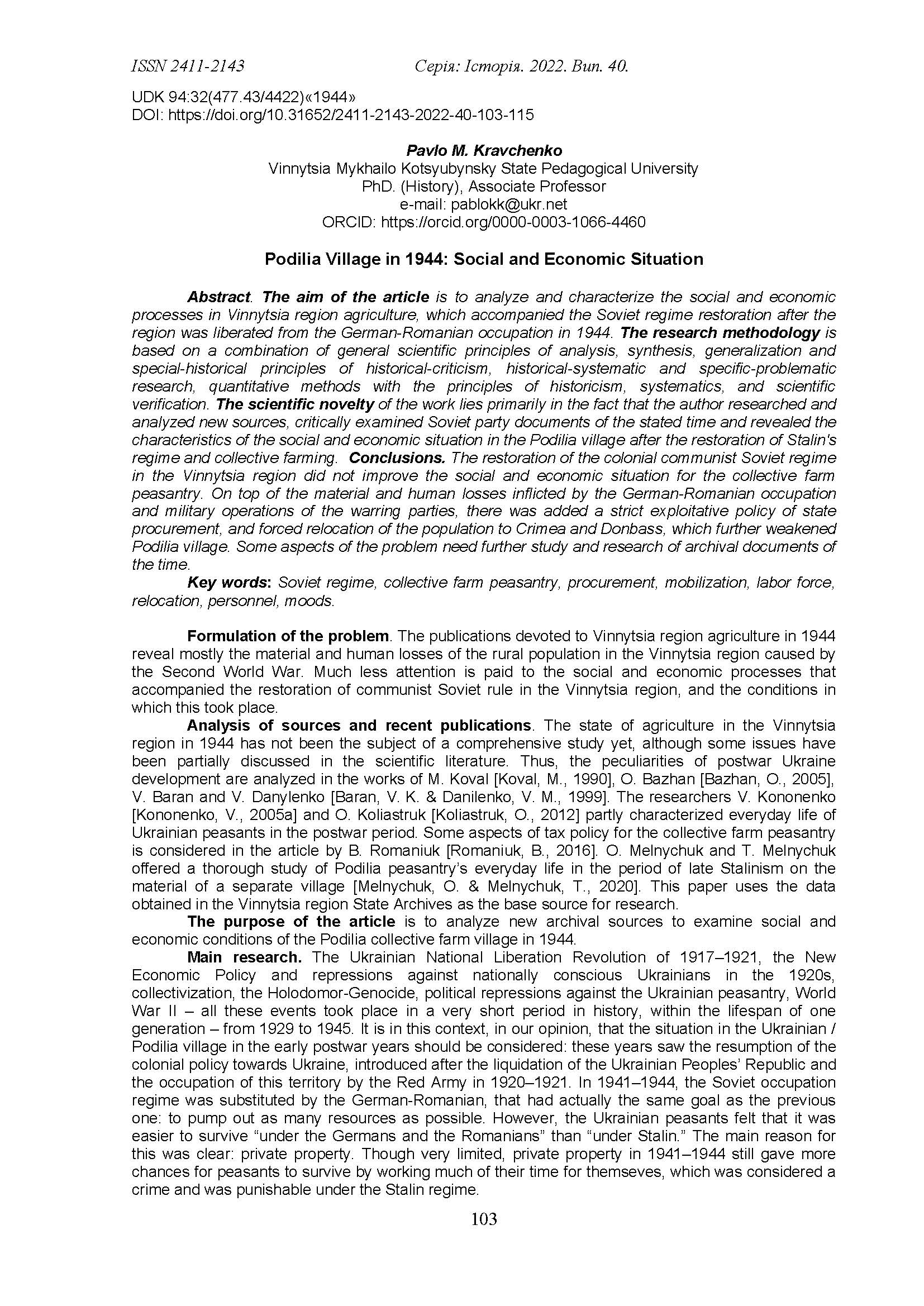Abstract
The aim of the article is to analyze and characterize the social and economic processes in Vinnytsia region agriculture, which accompanied the Soviet regime restoration after the region was liberated from the German-Romanian occupation in 1944. The research methodology is based on a combination of general scientific principles of analysis, synthesis, generalization and special-historical principles of historical-criticism, historical-systematic and specific-problematic research, quantitative methods with the principles of historicism, systematics, and scientific verification. The scientific novelty of the work lies primarily in the fact that the author researched and analyzed new sources, critically examined Soviet party documents of the stated time and revealed the characteristics of the social and economic situation in the Podilia village after the restoration of Stalin's regime and collective farming. Conclusions. The restoration of the colonial communist Soviet regime in the Vinnytsia region did not improve the social and economic situation for the collective farm peasantry. On top of the material and human losses inflicted by the German-Romanian occupation and military operations of the warring parties, there was added a strict exploitative policy of state procurement, and forced relocation of the population to Crimea and Donbass, which further weakened Podilia village. Some aspects of the problem need further study and research of archival documents of the time.
References
Бажан, О. (2005). Особливості відбудовчого періоду в Українській РСР у другій половині 40-х – на початку 50-х років ХХ ст. Наукові записки національного університету Києво-Могилянська академія. Т. 41. 20–29.
Баран, В. К. & Даниленко, В. М. (1999). Україна в умовах системної кризи (1946–1980-ті рр.). К.: Видавничий дім «Альтернатива», 304 с.
ДАВіО – Державний архів Вінницької області.
Даниленко, В. М. (2005). Повсякденне життя українських селян у повоєнний період (1945–1955 рр.). Україна ХХ ст.: культура, ідеологія, політика.. Вип. 9. 3–18.
Коляструк, О. А. (2012). Повсякденне життя українського суспільства у перші повоєнні роки (1944–1947). Наукові записки Вінницького державного педагогічного університету імені Михайла Коцюбинського. Серія: Історія. Вип. 20. 131–136. https://doi.org/10.31652/2411-2143-2012-20-131-136
Кононенко, В. В. (2005а). Становище українського селянства у повоєнний період (1945–1947 рр.). Український селянин, вип. 9. 234–236.
Мельничук, О. & Мельничук Т. (2020). Повсякденне життя колгоспного селянства Поділля у повоєнний період (1944–1953) (на матеріалах колгоспу «Червоний промінь» с. Мельниківці). Наукові записки Вінницького державного педагогічного університету імені Михайла Коцюбинського. Серія: Історія. Вип. 32. 52–63. DOI: https://doi.org/10.31652/2411-2143-2020-32-52-63
Романюк, Б. Особливості державної податкової політики для колгоспного селянства в перші повоєнні роки. Наукові записки Вінницького державного педагогічного університету імені Михайла Коцюбинського. Серія: Історія. Вип. 24. 105–108. https://doi.org/10.31652/2411-2143-2016-24-105-108

This work is licensed under a Creative Commons Attribution 4.0 International License.
Copyright (c) 2022 Павло Кравченко





